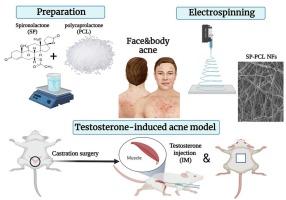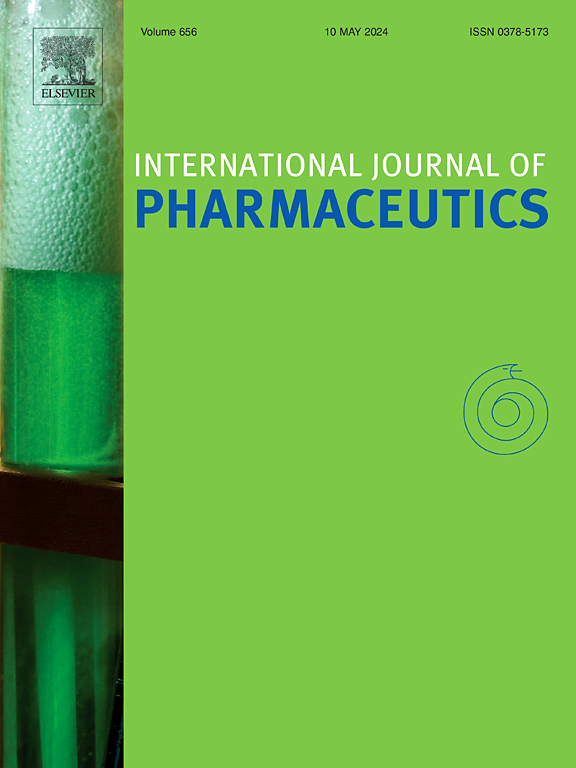在体内手术睾酮诱导的痤疮模型中促进螺内酯抗痤疮作用的控释3D纳米纤维支架。
IF 5.2
2区 医学
Q1 PHARMACOLOGY & PHARMACY
引用次数: 0
摘要
控释静电纺丝纳米纤维(NF)支架为螺内酯(SP)提供了一种很有前途的递送系统,可以改善其口服抗痤疮的用途,并克服其全身副作用。在本研究中,八种不同的聚己内酯(PCL)聚合物溶液被静电纺丝成NFs。最佳配方(PCL-h NFs)进一步加入SP (SP- pcl NFs)。扫描电镜结果显示,与其他配方相比,PCL-h NFs支架表面光滑均匀,平均纤维直径为500 nm。SP-PCL NFs保持结构均匀性,其直径尺寸无明显变化。原子力显微镜分析了PCL-f NFs和SP-PCL NFs的表面粗糙度,发现PCL-f NFs的表面粗糙度为138.5 nm, SP-PCL NFs的表面粗糙度为97.72 nm。还进行了其他表征,包括固体状态、水接触角、膨胀测试和力学研究。SP- pcl NFs的体外释放研究表明,SP- pcl NFs的SP释放量比纯SP有所增加,SP- pcl NFs的SP释放模式为初始少量的爆发释放,随后更稳定的控释,直至168 h。皮肤沉积研究表明,SP- pcl NFs的药物保留率是纯SP凝胶的8.5倍。小鼠体内睾酮诱导痤疮模型显示,SP-PCL NFs具有抗雄激素作用,与PCL NFs和纯SP凝胶相比,SP-PCL NFs可减少小鼠皮脂细胞增殖和总皮脂组织体积。总之,这些结果提示通过其抗雄激素活性治疗雄激素相关性痤疮的潜在治疗应用。本文章由计算机程序翻译,如有差异,请以英文原文为准。

Controlled release 3D nanofiber scaffolds for fostering the anti-acne effect of spironolactone in an in vivo surgical testosterone-induced acne model
Controlled-release electrospun nanofiber (NF) scaffolds offer a promising delivery system for spironolactone (SP) to improve its proven oral anti-acne repurposed use and overcome its systemic side effects. In the present study, eight different Polycaprolactone (PCL) polymeric solutions were electrospun into NFs. The best formula (PCL-h NFs) was further loaded with SP (SP-PCL NFs). Scanning electron microscopy showed that the PCL-h NFs scaffold has the smoothest homogeneous surface compared to the other formulae, with an average fiber diameter of 500 nm. SP-PCL NFs maintained structural uniformity, and their diameter size showed no significant change. The surface roughness of PCL-h NFs and SP-PCL NFs was analyzed using atomic force microscopy, revealing that Ra 138.5 nm for PCL-h NFs and Ra 97.72 nm for SP-PCL NFs. Additional characterizations, including solid state, water contact angle, swelling tests, and mechanical study, were also conducted. The in vitro release study for SP-PCL NFs showed an improvement in SP amount released compared to the pure SP, and the pattern of SP release from SP-PCL NFs was a minor initial burst release followed by more steady controlled release till 168 h. Skin deposition study demonstrated that SP-PCL NFs achieved 8.5 times drug retention compared to the pure SP gel. The In vivo testosterone-induced acne model in mice showed the efficacy of SP-PCL NFs as antiandrogenic NFs, as SP-PCL NFs reduced sebocyte proliferation and total sebaceous tissue volume in mice compared to PCL NFs and pure SP gel. In conclusion, these results suggest potential therapeutic applications for treating androgen-related acne through its anti-androgenic activity.
求助全文
通过发布文献求助,成功后即可免费获取论文全文。
去求助
来源期刊
CiteScore
10.70
自引率
8.60%
发文量
951
审稿时长
72 days
期刊介绍:
The International Journal of Pharmaceutics is the third most cited journal in the "Pharmacy & Pharmacology" category out of 366 journals, being the true home for pharmaceutical scientists concerned with the physical, chemical and biological properties of devices and delivery systems for drugs, vaccines and biologicals, including their design, manufacture and evaluation. This includes evaluation of the properties of drugs, excipients such as surfactants and polymers and novel materials. The journal has special sections on pharmaceutical nanotechnology and personalized medicines, and publishes research papers, reviews, commentaries and letters to the editor as well as special issues.

 求助内容:
求助内容: 应助结果提醒方式:
应助结果提醒方式:


